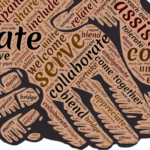Do you know how many decisions you make per day?
Each person makes a lot of decisions every day from the moment they open eyes. As per analysis of Roberts Wesleyan College it’s around 35 000 per day. What will I eat for breakfast?
Am I gonna eat?
What should I wear?
What’s the weather outside?
At work, which task should I do first, second..?
Decisions are often made based on past experience, personal values, facts.
What is actually the decision making?
Decision making is an act of choosing between two or more courses of action, and it represents part of the problem-solving process. Decisions can be made through either an intuitive or reasoned process, or a combination of the two. Some of us are more reasoning, using the facts and figures, ignoring emotional aspects. Others bet on their intuition, using their ‘gut feeling’ about possible courses of action. Intuition is actually a combination of past experience and your personal values.
What are the steps of the Decision Making Process?
Decision making process consists of the following steps
- Identification of a decision
- Gathering of information
- Identification of alternatives
- Weight of the evidence
- Analysis of risks
- Choosing among the alternatives
- Taking action
- Review the decision
Sometimes we are not even aware of the decisions we make. We follow the same routine. But if we look closer we may realize that some activity can be done differently, or that we actually have a problem which needs to be resolved. Then it’s important to go through each step of the decision making process, not skipping any. Once we review the decision taken, we may need to return to the beginning of the process and gather new information or identify new alternatives, etc.
Challenges of Decision Making
Having too much or not enough information
Gathering relevant information is key when approaching the decision making process, but it’s important to identify how much background information is truly required.
Misidentification of the problem
In many cases, the issues surrounding your decision will be obvious. However, there will be times when the decision is complex and you aren’t sure where the main issue lies. Conduct deep research and speak with experts. It will save you time and resources in the long run.
Overconfidence in the outcome
Even if you follow the steps of the decision making process, there is still a chance that the outcome won’t be desirable. Being overconfident in an unlikely outcome can lead to unfavorable results. That’s why it’s so important to identify a valid option that is acceptable and achievable.
Decision strategies
Impulsiveness – Leverage the first option you are given and be done with it
Compliance – Going with the most pleasing and popular option as it pertains to those impacted
Delegating – Pushing decisions off to capable and trusted others
Avoidance – Either ignoring as many decisions as possible in an effort to avoid responsibility for their impact or just simply to prevent them from overwhelming you
Balancing – Weighing the factors involved and then using them to render the best decision in the moment
Prioritizing – Putting the most energy, thought and effort into those decisions that will have the greatest impact
We normally employ a combination of several of these decision-strategies depending on a situation.
Wrong decision vs no decision
Studies show, it’s better to make some decision, than no decision. When making decisions, ask these two questions:
What is the impact if I get it wrong?
How much will it delay other things if I don’t move on this?
Without decision, there’s no progress, which can have consequences.
However, if you make a decision, there will be at least some progress and you can still adjust your decision to the new conditions at a later stage.
You often do not know if your decision is the right one until you implement it. You find it out only when you re-evaluate your decision over the time. The decision is always made at a time and based on information available. You still have an option to adjust your decision at a later stage once you have new information.










